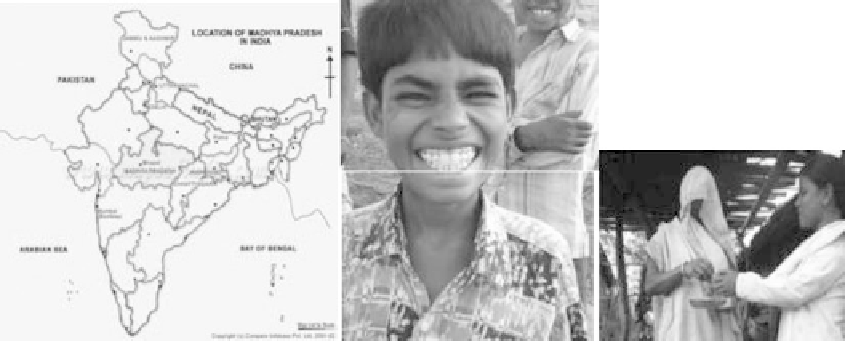Environmental Engineering Reference
In-Depth Information
symptoms lead to the identiication of luoride contamination as a problem in a region.
QCRA with data on health surveys provides the basis for use-based separation of water
sources. This should be followed by an IFM strategy involving various water management
solutions (including rainwater harvesting, gray water reuse), improved water deluorida-
tion techniques, and nutritional supplementation. This approach also offers a site-speciic
and practically more feasible solution for the effective mitigation of luorosis.
17.2.3.1.1 IFM—A Case Study in Madhya Pradesh, India (Adopted from Integrated
Fluorosis Mitigation Manual, UNICEF-CSIR-NEERI, 2007)
Madhya Pradesh is a central state in India. It has a population of >65 million with a high
tribal population. More than 80% of the 48 districts of Madhya Pradesh are affected by
elevated levels of luoride in drinking water. To mitigate luorosis, areas with both high
luoride in water and also a high prevalence of dental luorosis were identiied. Two dis-
tricts (Dhar and Jhabua) were taken as implementation sites, and a dental survey of 1000
children using the dean's survey and QCRA were undertaken in 2005 (Figure 17.2). This
was followed by the IFM intervention including water dilution and deluoridation, and
nutritional supplementation in both schools and communities. The QCRA followed the
approach outlined in the WHO Guidelines for Drinking Water Quality (vol. 3, 2004) and
involved hazard identiication, exposure assessment, dose response, and risk characteriza-
tion. The results of the QCRA indicated that 60% of the luoride is being consumed from
food and 40% is being consumed from water.
On the basis of the QCRA, three categories of risk were determined:
1. Class A—high-risk category (DALY >100/1000 persons), where the mitigation
included Information, Education and Communication (IEC), household deluori-
dation, nutritional supplementation, and water management
2. Class B—moderate risk category (DALY <100/1000 persons), including IEC, dilu-
tion of luoride affected water, and nutritional supplementation
3. Class C—low-risk category (DALY <10/1000 persons); IEC and nutritional
supplementation
FIGURE 17.2
Study area and activities related to IFM. (Adopted from
Integrated Fluorosis Mitigation Manual
, UNICEF-CSIR-
N E E R I , 2 0 0 7.)

